Lost Collections: Preserving Historical Biodiversity Memory—The Case of Peiroleri’s Manuscript Catalogue
Abstract
1. Introduction
2. Materials and Methods
3. Results
3.1. Peiroleri’s Catalogue: Attribution and Analysis
- Catalogue’s numerical ID
- Taxa (Genera in black ink, capitalized; specific epithets in red ink)
- Note
“Il Barone Peyroleri mastro auditore nella Camera dei Conti, [...] assai si dilettava d’insetti e ne aveva formato ampia raccolta [...]”
[“Baron Peyroleri master auditor at Board of Auditors, […] dabbled very much in insects and built a large collection of them”]
3.2. “Catalogo Coleotteri 1877”: Attribution and Analysis
“Dopo la morte del Bonelli la raccolta di Coleotteri del Museo Zoologico torinese, assai ricca per quei tempi, venne quasi intieramente distrutta dagli Antreni e dalla muffa. Essa cominciò a risorgere col materiale risultante dai viaggi del Gené fatti in Sardegna: e pochi anni dopo acquistò nuova importanza dall’aggiunta della raccolta di Coleotteri europei donata a questo R. Museo dagli eredi del Barone Peiroleri; se non che quest’ultima raccolta stata preparata col metodo antico, cioè colle gambe degli insetti orizzontalmente distese, venne per tal motivo, ad eccezione di pochi individui rari, quasi del tutto rilegata nei magazzeni di doppi e sostituita da individui meglio preparati, di cui infra.
Nell’anno 1850 il Marchese Ferdinando Arborio di Brême (defunto Duca di Sartirana) faceva dono a questo Museo della numerosissima e stupenda sua raccolta mondiale in coleotteri: ed è quella che in massima parte servì alla formazione della raccolta attuale, cui meritamente spetterebbe il nome di raccolta De Brême, ed alla quale si riferisce il presente catalogo. Notando che alla composizione di quella raccolta, fatta in Parigi, contribuirono l’intiera sezione degli Eteromeri non che le seguenti famiglie della famosa raccolta Dejean, cioè Malacodermi, Xilofagi (del catalogo Dejean), Clitre, Coccinelle ed alcuni Carabici estratti parimenti da quella collezione.”
[“Following Bonelli’s death, beetle collection of the Turin Zoological Museum, really rich for its times, was almost completely destroyed by carpet beetles and moulds. It began to rise again thanks to the specimens resulting from Gené’s voyages to Sardinia: and a few years later it gained more prominence thanks to the European beetles collection donated to this Royal Museum by baron Peiroleri’s heirs; although the specimens in this collection were mounted in the ancient way, that is to say with legs horizontally stretched, and was for this reason that, except for some rare specimens, they were almost entirely confined in the duplicates’ storage and replaced by better mounted specimens, about which below.
In the year 1850 Marquis Ferdinando Arborio di Brême (the late Duke of Sartirana) donated to this Museum his large and splendid world beetle collection: and it is that which for the most part formed the present collection, which deservedly should be named De Brême’s collection, and which this catalogue refers to. It must be highlighted that the composition of this collection, made in Paris, had the contribution of the entire Eteromera section and also the following Families of the renowned Dejean collection, that is to say Malacoderma, Xylophaga (according to Dejean’s catalogue), Clytra, ladybugs and some ground beetles also taken from that collection.” ]
“[...] la collezione degli insetti (del Museo Zoologico di Torino) […] deve il suo maggior pregio a ciò che in parte è costituita dalle antiche collezioni del conte Déjan comprate dal marchese di Brème e donate generosamente al Museo; in parte è costituita ancora dalle collezioni del barone Peiroleri, entomologo segnalato piemontese che fece pur esso il dono delle sue collezioni al Museo.”
[“[...] [MZUT’s] insect collection […] owes its prestige partly to what is formed by count Dejean’s ancient collections bought by marquis de Brème and generously donated to the Museum; partly to what is formed by baron Peiroleri’s collections, a renowned Piedmont entomologist who donated his collections to the Museum too.”]
“[...] poi vennero gli splendidi doni del Peiroleri, che spese una lunga vita in studi e collezioni di entomologia che si volsero tutti in prò del museo [...]”.
[“[...] then came the wonderful gifts from Peiroleri, who spent a long life in entomological studies and collections which all turned in favour of the museum [...]”]
- Gené’s collection of Sardinian specimens;
- de Brême’s collection;
- specimens from Dejean’s collection (originally in de Brême’s collection);
- specimens from Peiroleri’s collection;
3.3. “Catalogo Coleotteri 1877” and de Brême’s Collection
- specimens collected by Lessona (see Ghiliani’s note, Figure 11; partially transcribed, translated and adapted from Italian in Appendix G)
- specimens from Truqui’s collection
- specimens collected by De Filippi during his voyage on the vessel Magenta (1865–1868)
- specimens collected by Ghiliani, many of them during his voyage to Spain and Sardinia
- specimens coming from the explorations carried out during the second voyage of the Astrolabe (1837–1840)
- specimens coming from Duca degli Abruzzi’s Ruwenzori expedition (1906)
- several specimens coming from trades with, or donations by, 19th century naturalists (at the moment, it is not possible to establish with certainty which specimens have been added by MZUT collection curators and which were originally in De Brême’s, Gené’s or Peiroleri’s collections.
3.4. Peiroleri’s and Dejean’s Platynus spp. Specimens
3.4.1. Spinola’s Coleopterological Collection
3.4.2. De Brême’s Collection
3.4.3. General Historical MZUT Collection
3.5. Type Specimen Identification
4. Discussion
Funding
Institutional Review Board Statement
Data Availability Statement
Acknowledgments
Conflicts of Interest
Appendix A. Peiroleri-Related Species in “Mémoire Sur la Station de Quelques Coleopteres dans les Différentes Régions du Piémont” (Ghiliani 1847)
- Dermestes roseiventris, Peiroleri. (D. catta? Panz.) Seen in great numbers on small corpses; sometimes it can be found together with D. holosericeus, Bonelli, and D. bicolor, Fabr., but it is always rare; speaking of D. ater, Oliv., which can be found both on carrions and some umbellifer flowers, it is common in winter, hidden under the moss at the foot of trees. (p. 92–93)
- Ditomus calydonius, Fabr. Baron Peiroleri was the one who found this insect in May 1812, on the hills of Turin. This species’ presence in such a place is an extraordinary fact for our entomology, and one must disregard what Ponza says in his Coleoptera salutientia, in which he confuses this species with Cephalotes vulgaris, Bonelli, since he admits he has never found the male, while saying it is a common species. (p. 102)
- Rhynchites coeruleocephalus, Fabr. Really rare, as well as R. proeustus Peiroleri, which he has collected in the surrondings of Turin. (p. 115)
- Pterostichus bicolor, Peiroleri. This insect is constantly the same all along the line of the Maritime Alps and of the Genoese Appenine, I cannot admit it is a variety of P. Jurinei, Panz., like one usually thinks, especially since the latter has been seldom found in the Northern Alps; moreover, our P. bicolor, which has excessively multiplied towards the upper parts of this region, can still be found at 1900 metres of elevation and seems to represent here P. externepunctatus, Sturm., of the Northern Alps. (p. 116)
- Platynus Peirolerii, Gené. (Bassi.) It stays under the stones in open areas throughout the entire Maritime Alpine chain, where this insect is not rare. (p. 117)
- Pterostichus impressicollis, Peiroleri. It is a mistake that in Dejean’s catalogue this species is found together with P. parumpunctatus, Dej. as a variety of the latter; if one has to destroy this species, it is to P. vagepunctatus Bonelli that we must relate it, although the latter always lives in a higher zone, while our P. impressicollis never goes higher than 1400 metres and often descends in the narrows that block the entrance of valleys where they meet the plain, places tipically cold for their elevation. (p. 122)
- Pterostichus impressus, Peiroleri. This insect lives a solitary life under great stones in the same places where one can find Platynus erythrocephalus, and in the same way it is not rare in certain woods of this region and of the subsequent one; it is found between Moncenisio and Tenda pass. (p. 123)
- Pterostichus vagepunctatus, Bonelli. This insect, that can be likened to P. impressicollis, Peiroleri, emits like the latter a strong rose odor, which completely overwhelms the ones normally emitted by other carabids; it is found in abundance under the stones along the creeks that flow down from the meadows on the top of this area near Monviso; it reaches up to 2500 metres of elevation in the subsequent region. (p. 126)
- Dasytes ruficollis, Bonelli, inéd. Rare in our mountains as well as D. niger, Fabr., to which it resembles; it is remarkable for its red thorax; this species had already been found in Bonelli’s time and since then by Baron Peiroleri. Would it be Dasytes thoracicus, Dej., which is unknown to me? I am inclined to believe so, because the latter is indicated as belonging to southern France and that I saw our D. ruficollis on the island of Sardinia; however, the examples are common, as an insect inhabiting southern Europe, it is also found in some Alpine recesses, which receive the reverberated heat of the nearby rocks; the order of Lepidoptera gives us many examples, and among Neuroptera I can mention Myrmeleon libelluloides which is found not far from Turin at the entrance to the Susa valley, although this species is essentially southern. (p. 135)
- Tragosoma depsarium, Fabr. Really rare on coniferous trunks; found by Baron Peiroleri. (p. 137)
- Acmaeodera feisthameli, Gory. This superb species has been found not far from Domodossola, by Baron Peiroleri (p. 139)
- Cychrus angustatus, Dej. This insect found in Monviso, was seen in Sempione by Baron Peiroleri, in Mount Legnone in Lombardy by Messrs Villa, from Milano; lastly, if this species is the same as the one described by Mr. Hope, as belonging to Carinthia, it is very curious to see this insect appear in some preferred localities at such great distances on such an extended line of the same mountain range. (p. 140)
- Oreina melanocephala, Meg. (O. Peirolerii, Bassi.). Mr. Zumstein, well known for his geological observations and his ascents of Monte Rosa, found this beautiful species first while searching for beetles for the late Bonelli; in the information he had the complacency to give me about the localities where this insect can be found sheltered under the stones, M. Zumstein assured me that since then he had not found, in the same place, individuals others than those of an ash-greenish colour. This circumstance appears to support the strong variations to which this species may be subject to; I saw an individual found on a top of the same point, in the Pennine Alpine range, which, on a red brick background, showed a large black line on the elytral suture. (p. 142)
Appendix B. Peiroleri-Related Species in “Elenco Delle Specie di Coleotteri del Piemonte” (1887, Ghiliani and Camerano)
- Cicindela sinuata Fabr. Really common during July and August along the creeks, in the vallies near Bra; seldom it has also been observed near Carmagnola and Moncalieri, according to Baron Peiroleri; I found it in the debris carried by Po’s flood in June. (p. 5)
- Cicindela flexuosa Fabr. This species, really common in the Tortona area, has been seen by Baron Peiroleri. (p. 5)
- Zuphium olens Fabr. Collected in Casale during summer, while flying in the evening along the Po, by Baron Peiroleri. (p. 6)
- Ditomus calydonius Fabr. This insect from southern Europe, where it does not go far from the Mediterranean shoreline, was collected in 1812 by Baron Peiroleri on the Turin hill during the month of May: it is also mentioned by Ponza, Coleoptera Salutientia, as frequent in that area on the sands of the Po, but be it that this place was explored many times by baron Peiroleri who said to me that he never saw it, be it because Ponza says he only encountered females, one can suspect that he was wrong in his identifycation, and I never saw it in river sands in those villages where it is abundant. (p. 9)
- Leistus nitidus Dufts. Caught by baron Peiroleri near the Savoia borders: in the same way, I found it in Maritime Alps at the beginning of June and in the Monviso towards the end of the month (rare). (p. 13)
- Badister cephalotes Dej. Extremely hard to observe, this species is to be found in the area sorrounding Turin, according to Baron Peiroleri; I have never oberved it. (p. 16)
- Platynus peirolerii Bassi. Described by cav. Bassi together with P. erythrocephalus. I warn that in the beautiful plate accompanying the description there is an error in proportions, that is that P. Peirolerii is depicted much bigger than the other, exactly the opposite of reality; I found it in Monviso and it is really common in Maritime Alps. (p. 18)
- Agonum triste Dej. Seen in the Saluzzo province by Baron Peiroleri. (p. 19)
- Platysma maura Dufts. It lives in our Alps, where, however, it is not abundant; so I will tell about Pterostichus parnassius Bon., that is because the lack of carina under the last abdominal segment should make it evidently close to Platisma maura, but I doubt it is to be considered a variety of it as depicted in Dejean’s catalogue and I am determined to study both of them better. Regarding bilineipunctata Bon. variety, it is not possible to know the truth anymore, having found, under this name, in baron Peiroleri’s collection and in our ancient collection, sometimes P. parnassius varieties and sometimes Pterostichus yvanii Dej. ones. (p. 21)
- Pterostichus impressicollis Peiroleri. From lower heights till the end of the tree line, where it appears to change to the following [P. vagepunctata] (p. 22)
- Pterostichus peirolerii Heer. Really common in the Ligurian Appennine, mount of Bobbio, etc. (p. 22)
- Pterostichus flavofemorata Bonelli (var. 6a, punctata Peiroleri, inedita, full-black legged variety). It dwells especially the mountain range from Gran San Bernardo to Sempione. (p. 22)
- Pterostichus impressa Peiroleri. I have often found this big and beautiful species under the stones, in larch and pine trees woods, from Fenestrelle to the South of Monviso; uncommon, it lives in isolation and prefers dry soil. (p. 23)
- Pterostichus bicolor Peiroleri. Common in the Ligurian Appennine and Maritime Alps; this species, in my opinion, must not be considered just a variety of yurinei Panz., since it has constant characters that make it stand apart. (p. 23)
- Pterostichus multipunctata Dej. It looks like it is abundant only in the surroundings of Monte Rosa; it is seldom found in the Gran San Bernardo mountain range. A specimen can found in baron Peiroleri’s collection, under the name sculpturalis mihi, which in my opinion might perhaps be considered as a variety of multipunctata. (p. 23)
- Harpalus ditomoides Dej. Found by baron Peiroleri along the Po, flying, in Turin, in mid-July. (p. 27).
- Hydroporus silphoides Peiroleri, Ponza (obscurus Hon.). Borgomanero. (p. 35)
- Lomechusa strumosa Fabr. Found in the Alps by baron Peiroleri (and by me), also in Savoia. (p. 42)
- Acmaeodera feisthameli Gory. Collected by baron Peiroleri in Domodossola valley, and believed by him to be A. 18 guttata Herbst. but clearly, based upon Mr. Gory’s work in his supplement on Buprestidae, this species is different and was named A. freisthameli by the above mentioned author; we have to add to his description: black thorax, cerulean elytra, and black colour not prevailing. (p. 59)
- Agrilus auripennis Solier, Gory. It can be found, unidentified, in baron Peiroleri’s collection, found by the same during May in Stupinigi’s woods, then by me in Mandria (Agrilus coryli Dall’Anders). (p. 62–63)
- Spercheus emarginatus Fabr. Found since the time of Bonelli and by baron Peiroleri near Casale. Found in Carmagnola by Dr. Rubinetti. (p. 81)
- Rhisotrogus lutescens Lut., Sturm.?, insubricus Villa (vicinus Dej.). Discovered by baron Peiroleri near Casale (surroundings of Morano and Dogliani); at the beginning of September; it flies during the evening in the meadows. (p. 90)
- Omaloplia brunnipes Bon., Spec. Faun. subalp., pag. 156. nuda Ziegl. This species is found quite frequently during May in the woods near Susa; two ancient specimens from our Museum were identified for sure by Bonelli himself, they do not look different from nuda Ziegl., hungarica Mag. (in litteris Burmeister). Since the characteristics given by Mr. Burmeister to his brunnipes after Mr. Mulsant’s description, differ very little from our species, and that the essential one of the 10 articles of the antennae is not lacking in the two specimens from our collection. Also the individuals identified as nuda Ziegl. in baron Peiroleri’s collection, marquis De Breme’s collection e from Sardinia (Gené) are identical to ours from Piedmont but they just have 9 antennal articles. Due to the fact that Bonelli does not mention the numbers of articles of the antennae, it is quite logical to identify his brunnipes as our specimens from Piedmont but with just 9 articles. If then the nuda of Ziegl. has 10 articles, ours would be graminicola var. Fabr. (p. 91)
- Athous rufus Fabr. Found by baron Peiroleri in Vallese, this insect most likely could be likewise found, diligently searching, in this side of the Sempione mountain. (p. 94)
- Cardiophorus albipes Meg. Found by Peiroleri and me in the mountains of Viù; by me in the Maritime Alps (p. 96)
- Cryptohypnus minutissimus Peiroleri. This tiny insect looks like it lives interchangeably on different shrubs; I saw it really abundant in June on ligustrum leaves in a barren place. (p. 97)
- Dyctyopterus affinis Payk. Found by baron Peiroleri in the Alpes of Viù, in Ivrea by me. (p. 100)
- Anobium morio Villa. Really rare (maybe a variety of pertinax Fabr., named ruficornis by baron Peiroleri) (p. 110)
- Necrophilus subterraneus Illig. A specimen of this extremely rare species was collected by baron Peiroleri at the Vallese border, and by me in the Sempione mountain. (p. 113)
- Otiorhynchus clavipes Schön. (Peiroleri, ined.). Really common in Maritime Alps, it can be found in Monviso and Monte Rosa too. (p. 137)
- Tragosoma depsarium Fabr. Extremely rare. Found by baron Peiroleri in the Gran San Bernardo forest, on the trunks of pine trees and larches. (p. 155)
- Agapanthia asphodeli Latr. According to baron Peiroleri this species should exist on the Superga hill, where it is indeed possible to find a plant of this genus, Asphodelus ramosus. This insect must be extremely rare since I never saw it in our country. (p. 162)
- Pachyta lamed Fabr. In Formazza a really big female. This insect, extremely rare in our Alps, was collected near Saint-Didier in the Aosta Valley by baron Peiroleri, and by me on the top San Martino Valley, not far from the 13 lakes. (p. 163)
- Lema flavipes Meg. This species was rarely seen by baron Peiroleri during springtime in the surroundings (by me in Tortona). (p. 167)
- Plectroscelis sahlbergi Gyll. This species was seen in the Alps by baron Peiroleri (by me during the Po’s flood in springtime. (p. 173)
- Oreina peiroleri Bassi (Annales de la Société Entomologique de France, vol. 3, p. 465); (id., id, 1856, p. 545). Extremely rare near Monte Rosa. It was found for the first time in July by Mr. Zumstein then by me in Monviso and in Formazza. This species manifests a variety with a black suture of the elytra. (p. 176)
- Lina lapponica Fabr. This insect, extremely rare in our area, was collected by baron Peiroleri in Monviso and by me in a mountain near San Bernardo. (p. 176)
- Homalopus loreyi Dej. (I wrote in my Memoire: Ann. Soc. Entom., that major Villa is maybe the male). Years ago in a patch of oaks, I found this insect on our hill, where it has to be extremely rare; it was observed by baron Peiroleri in Aix in Savoy. (I found a specimen in Mandria on 30th of April on a hazel tree, Mr. Baudi found many specimens on the same day and Truqui found it on oak near Ivrea). (p. 180)
- Cryptocephalus stragula Rossi. This beautiful species was collected in May by baron Peiroleri on the Superga hill, then by me in early June at Eremo. (p. 181)
Appendix C. Peiroleri-Related Species in “Catalogo dei Coleotteri del Piemonte” (Baudi, 1889)
- Cicindela flexuosa Fabr. Mentioned by Ghiliani as found by baron Peiroleri in the Tortona area, I do not think it lives in Piedmont; it is a species that does not go far from sea beaches: it is likely that there was an error in identification or collection site. (p. 6)
- Plectes depressus Bon. (id. Cat. Ghil. p. 204) var. peirolerii Villa = intermedius Heer Northern Alps, Vigezzo Valley in Ossola. (p. 7)
- Pterostichus Bon. (Feronia sectio Cat. Ghil., p. 213) impressus Fairm. (id. Peiroleri, pag. 215) (p. 25)
- Pterostichus Bon. (Feronia sectio Cat. Ghil., p. 213) bicolor Heer (id., Peiroleri l. c.). (p. 25)
- Pterostichus Bon. (Feronia sectio Cat. Ghil., p. 213) planiusculus Chaud. (peirolerii Heer, p. 214). It can be found, other than in the Ligurian Appennine, in the Alps, Colle Assietta, etc., uncommon. (p. 25)
- Pterostichus Bon. (Feronia sectio Cat. Ghil., p. 213) vagepunctatus var. impressicollis Fairm. (id. Peiroleri, l. c.). Variety of higher regions. (p. 26)
- Platynus peirolerii Bassi (id., l. c.) (p. 29)
- Hydroporus obscurus St. (silphoides Peiroleri, Ponza, p. 227) (p. 35)
- Dermestes Lin. (id. Cat. Ghil. p. 309) murinus Lin. var. roseiventris Cast. (roseiventris Peiroleri p. 310) It can be found sometimes in great numbers on mole corpses hung on trees (p. 101)
- Cryptohypnus Esch. (id. cat. Ghil., p. 239) minutissimus Germ. (id. Peiroleri, l. c.) common, also often on hawthorn flowers (p. 120)
- Otiorrynchus Germ. (id. Cat. Ghil. p. 237) griseopunctatus Bohm (id. Dej. p. 329) var. clavipes Bohm. (id. Schön. et Peirolerii Chevr. l. c.) (p. 153)
- Oreina Chevr. (Oreina id. Cat. Ghil. p. 367) melanocephala Duft., (Peirolerii Bassi p. 368) (p. 202)
- Crepidodera Chevr. (id. Cat. Ghil. p. 362) Peirolerii Kutsch. (id. Dej. l. c.), also in Maritime Alps. (p. 206)
Appendix D. “Added Notes” by Ghiliani, Attached to “Catalogo Coleotteri 1877”
- Transcription
- Translation
Appendix E. Ghiliani’s Note Attached to “Catalogo Coleotteri 1877”
- Transcription
- Translation
Appendix F. Lessona’s Note about Ghiliani’s Death
- Transcription
- Translation
Appendix G. Ghiliani’s Note about Lessona Specimens
- Partial transcription
- Translation
References
- Meineke, E.K.; Davies, T.J.; Daru, B.H.; Davis, C.C. Biological collections for understanding biodiversity in the Anthropocene. Phil. Trans. R. Soc. B 2018, 374, 20170386. [Google Scholar] [CrossRef] [PubMed]
- Harvey, J.A.; Tougeron, K.; Gols, R.; Heinen, R.; Abarca, M.; Abram, P.K.; Basset, Y.; Berg, M.; Boggs, C.; Brodeur, J.; et al. Scientists’ Warning on Climate Change and Insects. Ecol. Monogr. 2022, 93, e1553. [Google Scholar] [CrossRef]
- Bassi, M.C. Description de quelques nouvelles espèces de Coléopteres de l’Italie, par M. C. Bassi (de Milan). Ann. Soc. Entomol. Fr. 1834, 3, 463–472. [Google Scholar]
- Dejean, P.F.M.A. Species Général des Coléoptères de la Collection de M. le Comte Dejean; Mequignon-Marvis: Paris, France, 1831; Volume 5, pp. 717–718. [Google Scholar]
- Ghiliani, V. Mémoire sur la station de quelques coléoptères dans les différentes régions du Piémont. Ann. Soc. Entomol. Fr. 1847, 5, 83–142. [Google Scholar]
- Ghiliani, V.; Camerano, L. Elenco delle specie di coleotteri trovate in Piemonte. Ann. R. Acc. Agricol. Torino 1887, 30, 1–188. [Google Scholar]
- Baudi di Selve, F. Catalogo dei Coleotteri del Piemonte; Tip. Lit. Camilla E. Bertolero: Turin, Italy, 1889; pp. 1–226. [Google Scholar]
- Poggi, R.; Conci, C. Elenco delle collezioni entomologiche conservate nelle strutture pubbliche italiane. Mem. Soc. Entomol. Ital. 1996, 75, 3–157. [Google Scholar]
- Passerin d’Entrèves, P. Figure dell’entomologia piemontese (Riassunto). Atti XIII Congr. Naz. Ital. Entomologia 1983, 31–34. [Google Scholar]


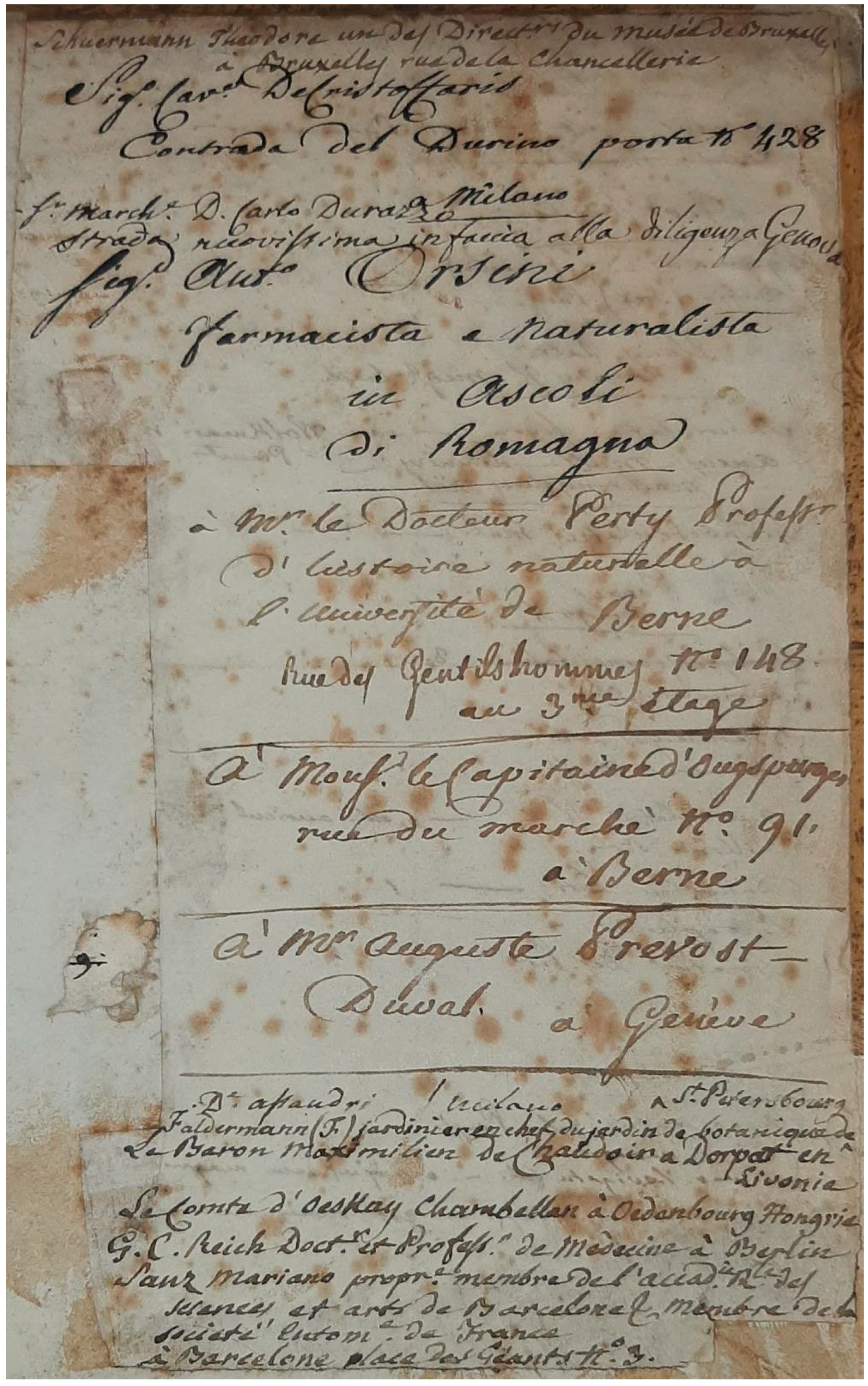


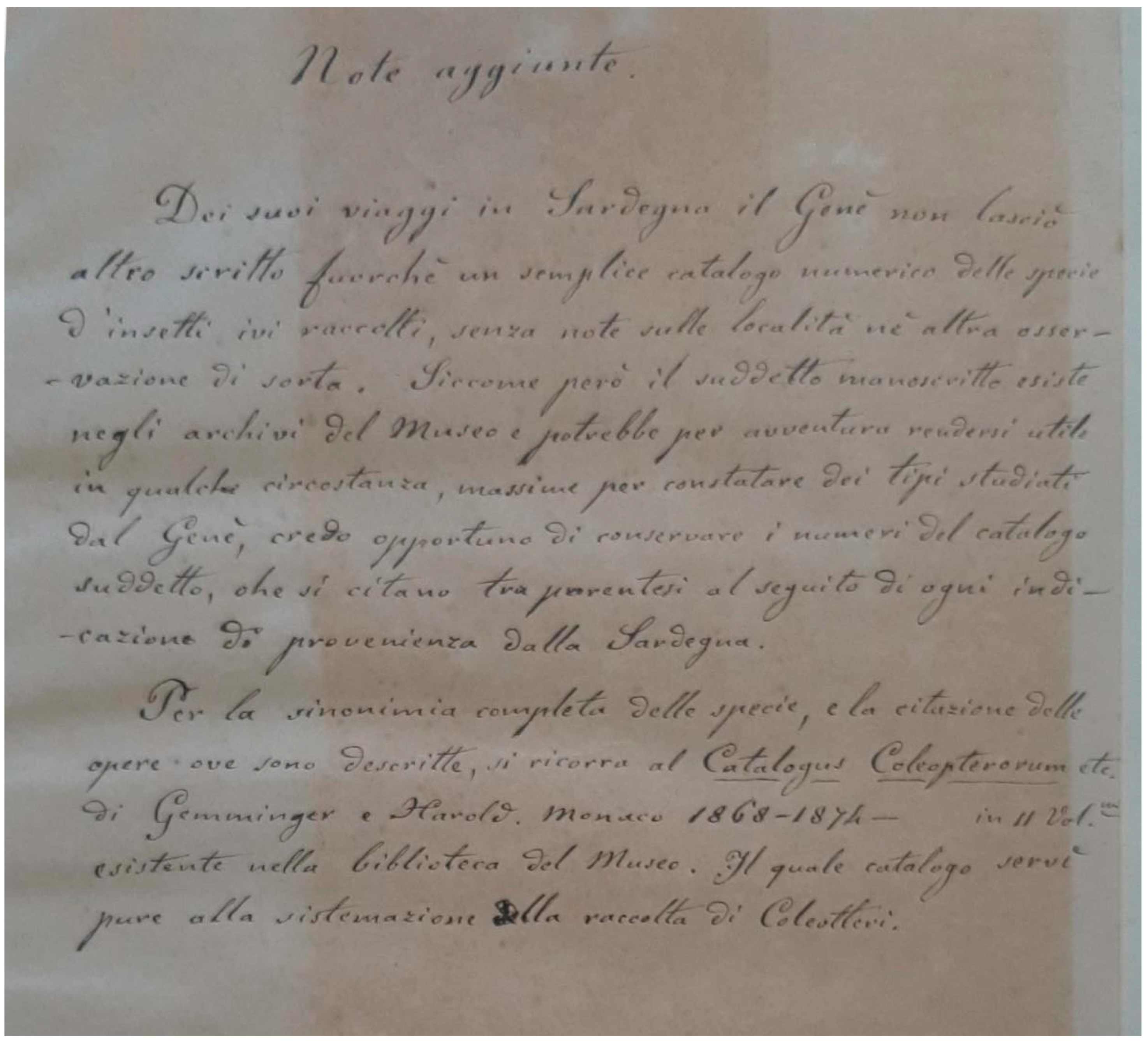



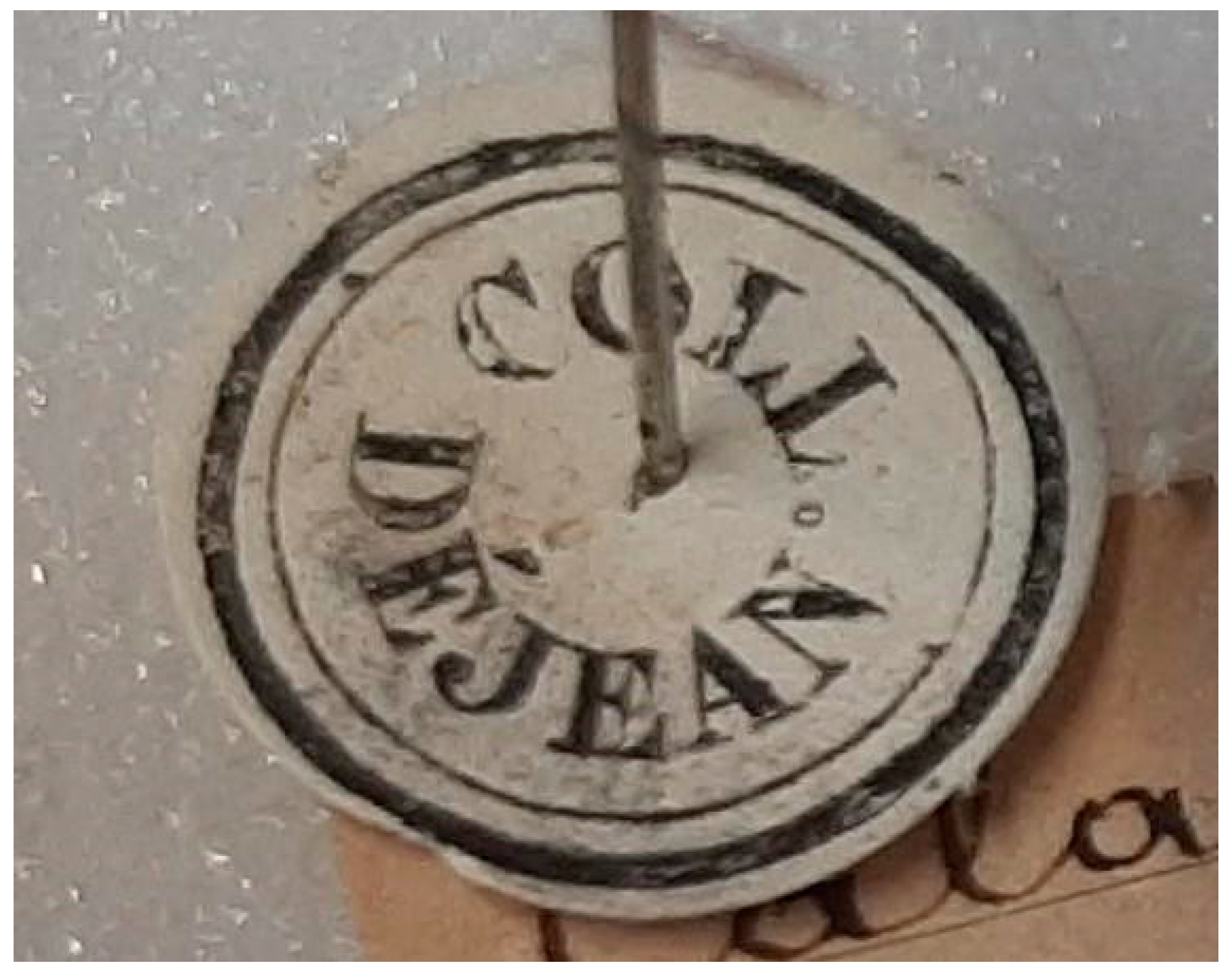
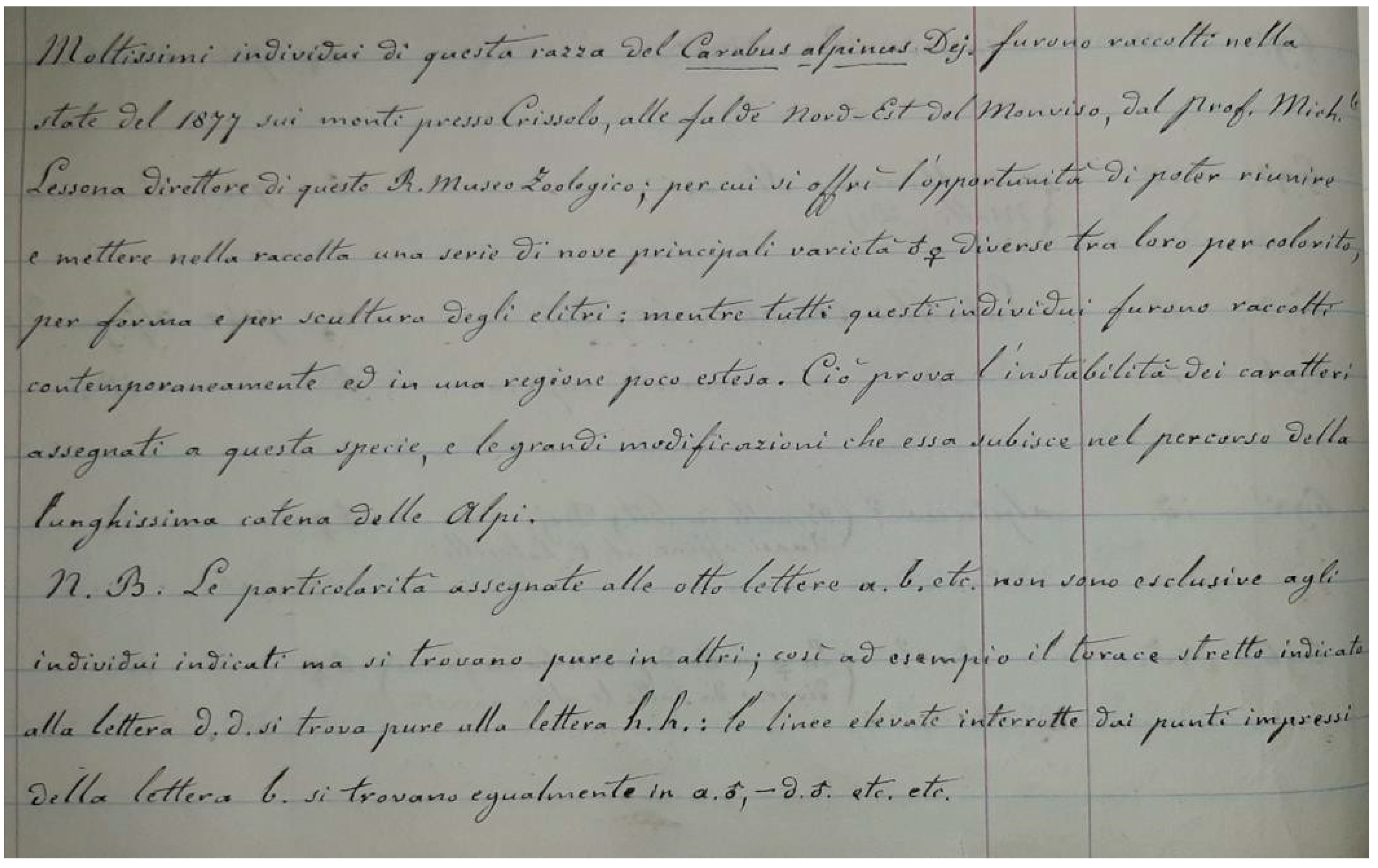


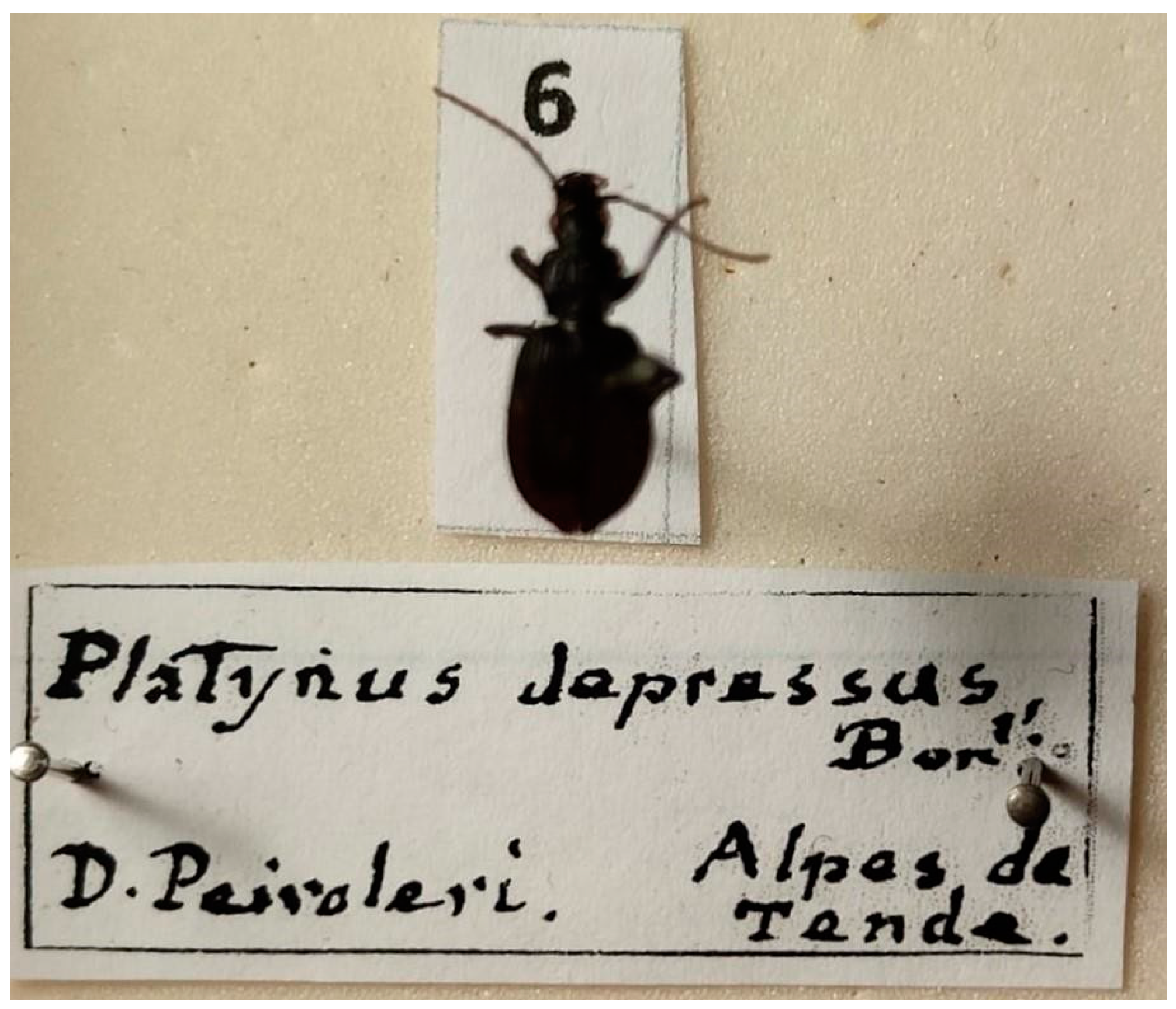
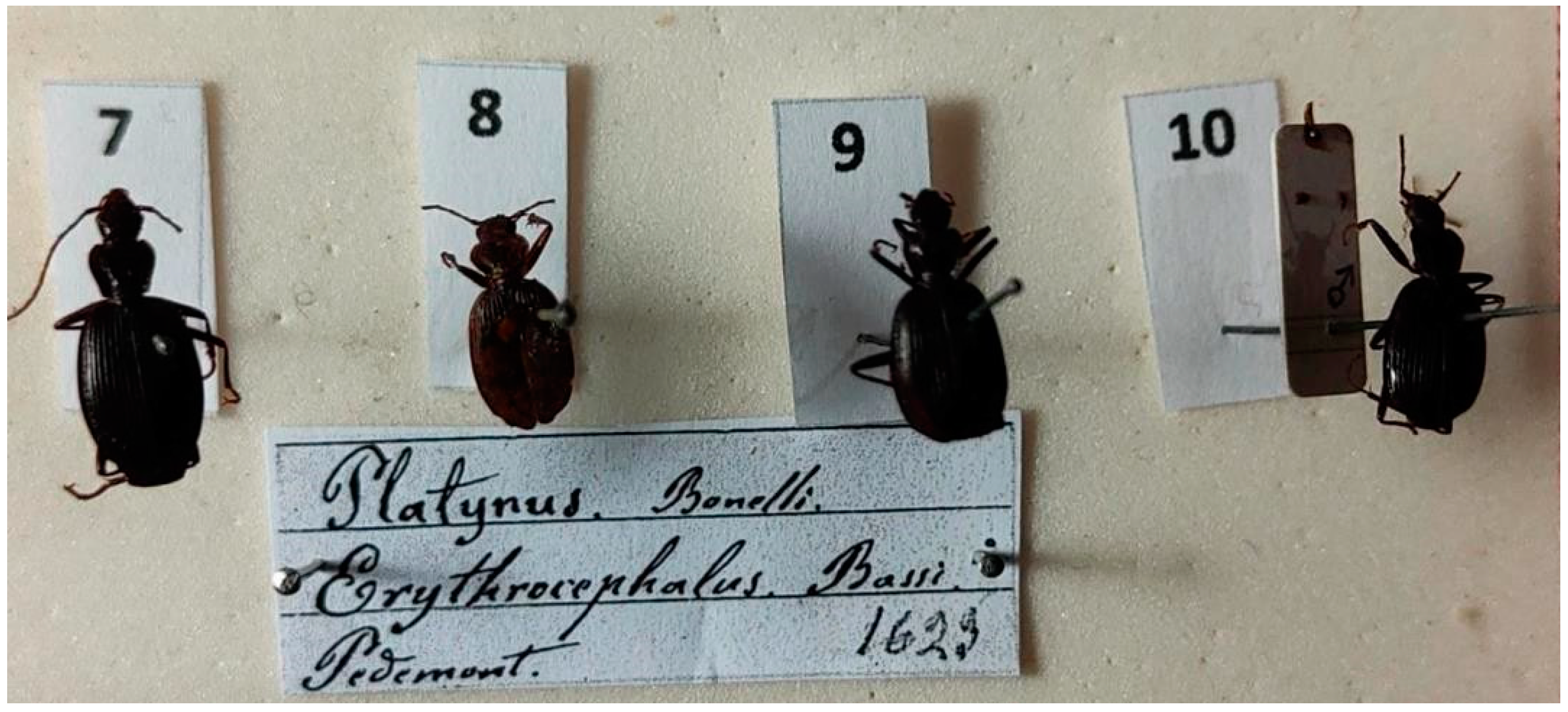
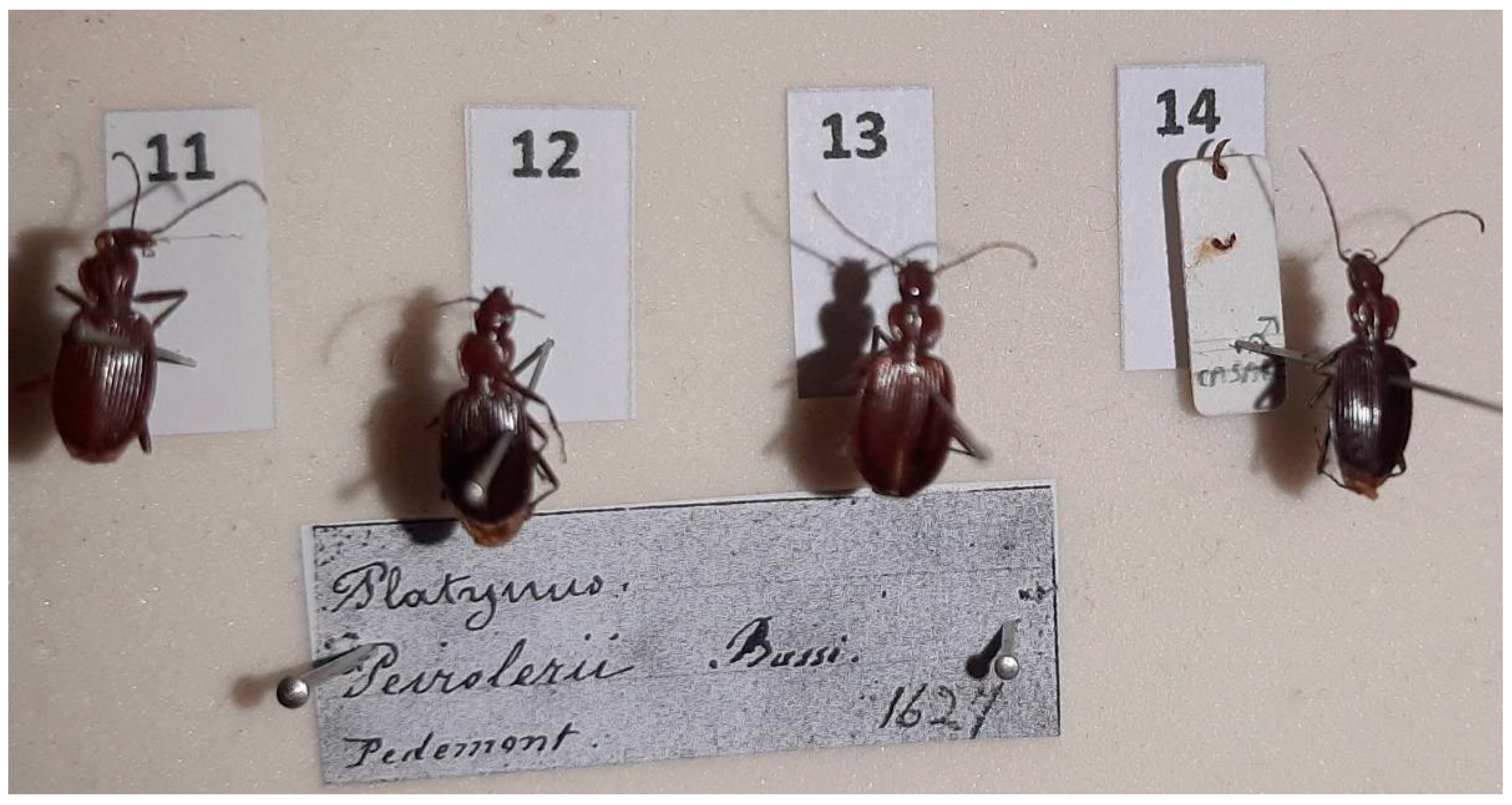





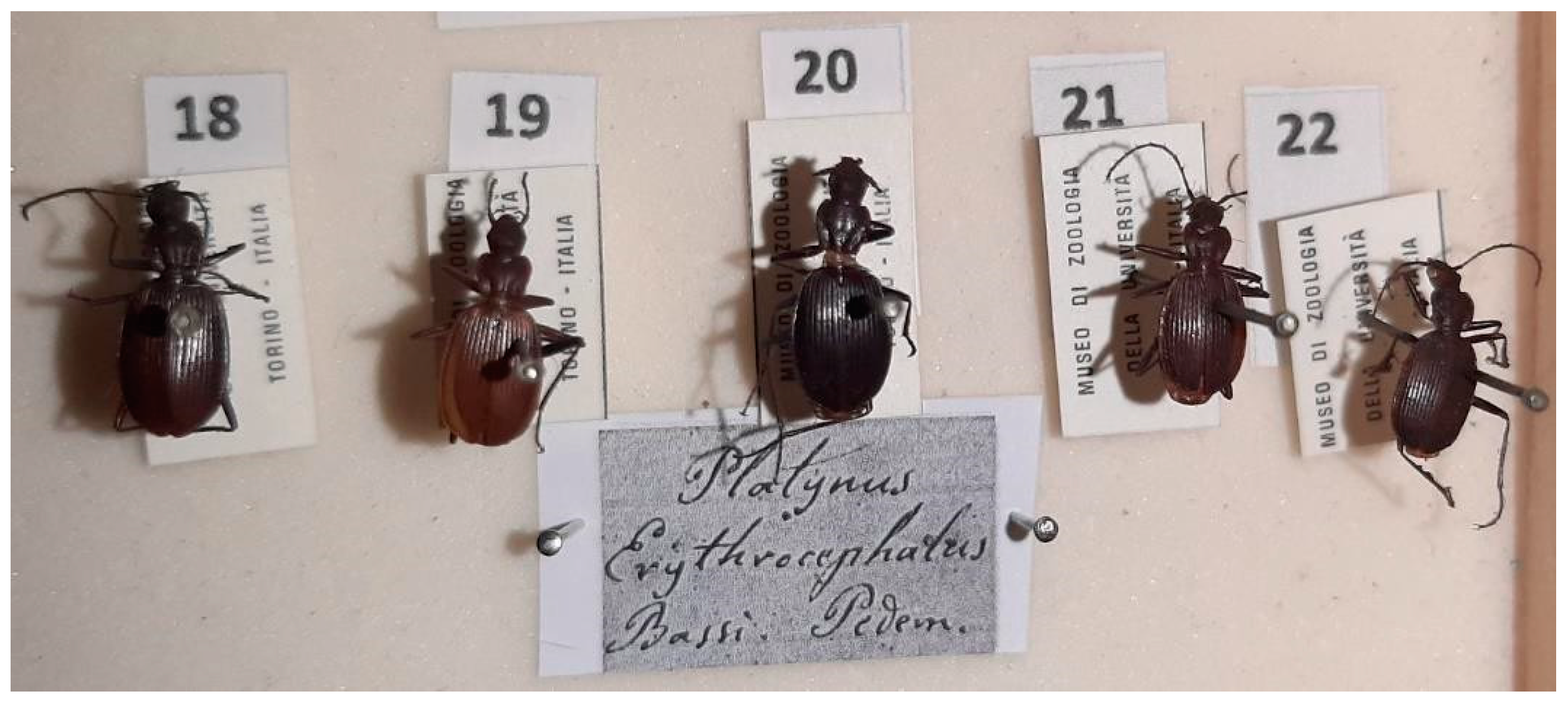
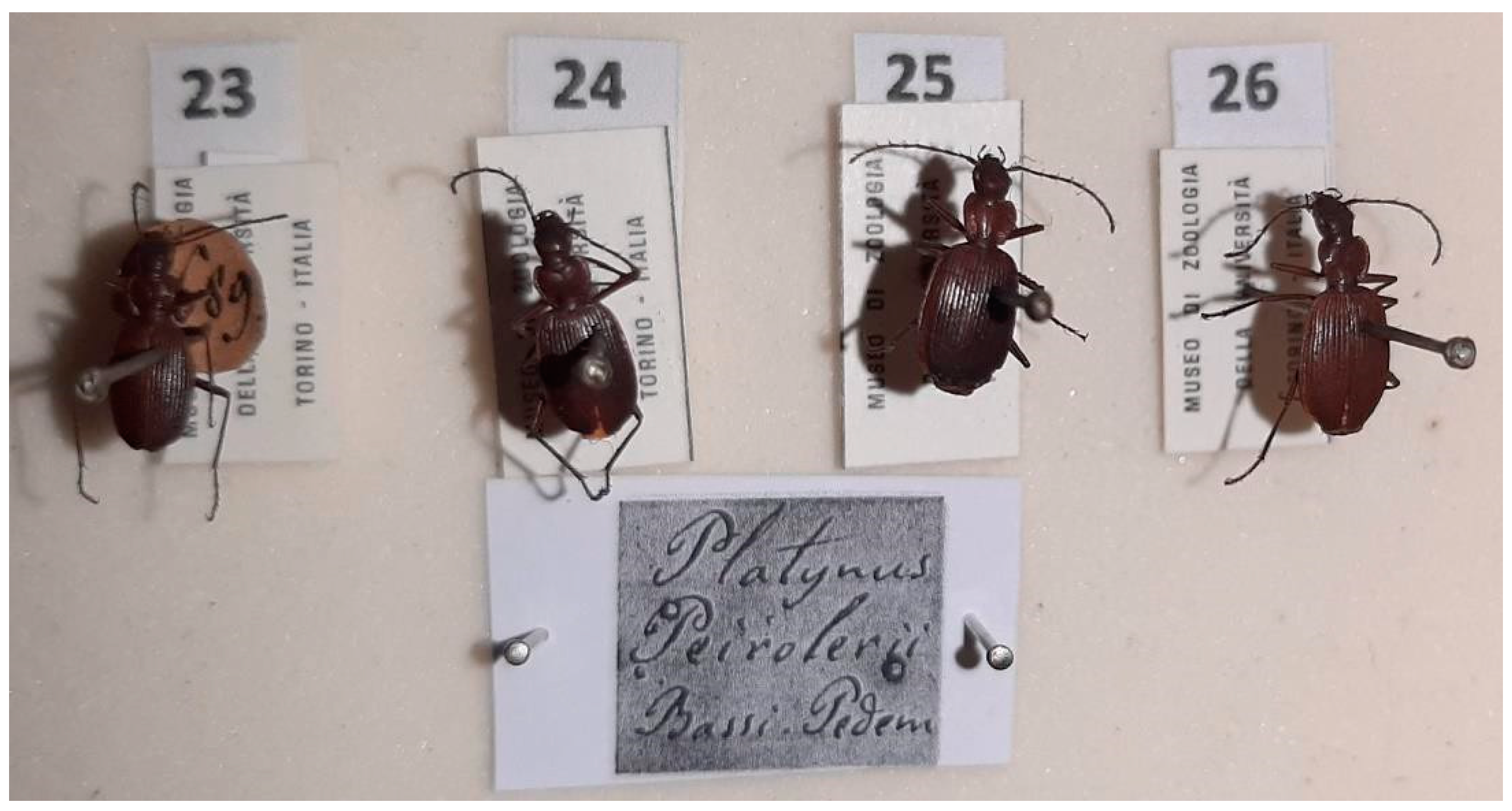
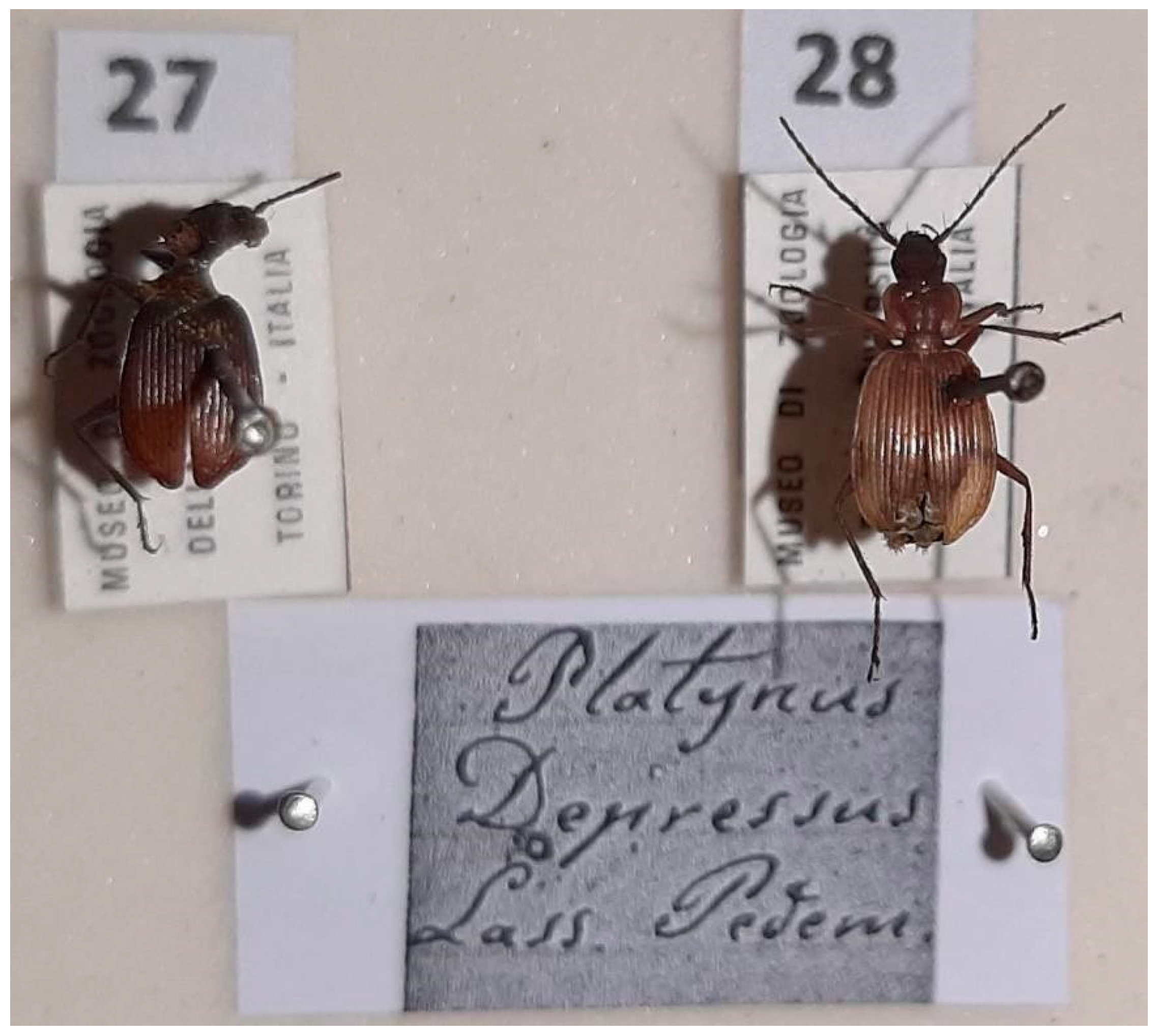
| Catalogue’s Numerical ID | Genus 1 | Species 2 | Notes |
| Genus. | Species | Author | Origin | Spec. No. | Collect. Site | No. Cat. 1877 | De Brême’s Box | Peiroler’s ID No. |
|---|---|---|---|---|---|---|---|---|
| Acupalpus | rufulus 1 | Dejean | n.d. | 3 | Piedmont; Gaul; Sardinia | 2456 | Pentameres Carabiques 124–126 | 84 |
| Anthaxia | discicollis | Frivaldski, Gory | n.d. | 1 | Romelia | 4243 | Sternoxes Buprestidae 42–44 | 4213 |
| Anthaxia | signaticollis | Dejean | n.d. | 6 | Southern Russia | 4242 | Sternoxes Buprestidae 42–44 | 4214 |
| Anthaxia | cupressi | Stentz | n.d. | 1 | Dalmatia | 4229 | Sternoxes Buprestidae 42–44 | 5001 |
| Athous | rhombeus | Olivier | n.d. | 3 | Sabaudia | 4610 | Pentameres Stenoxes (Bupr.) 76–78 | 3198 |
| Buprestis | cupressi 2 | Dejean | n.d. | 2 | Dalmatia | 4144 | Sternoxes Buprestidae 34–36 | 4262 |
| Capnodis | porosa 3 | Klug | n.d. | 4 | Mount Lebanon; Smyrne | 4068 | Sternoxes Buprestidae 26–28 | 4313 |
| Chrysobothris | calcarata 4 | Chevrolat | n.d. | 5 | Mexico | 4197 | Sternoxes Buprestidae 38–40 | 4235 |
| Dicerca | berolinensis 5 | Stentz | n.d. | 2 | Dalmatia | 4082 | Sternoxes Buprestidae 26–28 | 5000 |
| Eucnemis | rugulosus | Dejean | Dono Villa | 1 | Lombardy | 4421 | Pentameres Sternoxes (Bupr.) 56–58 | 3437 |
| Gyrinus (?) | non det. 6 | n.d. | n.d. | 1 | Chile | n.d. | Pentameres Hydrocantares 10–11 | 3421 |
| Hydroporus | fenestratus | Escher, Aubé | n.d. | 1 | Sicily | 2811 | Pentameres Hydrocanthares 7–8 | 3036 |
| Nemathodes | elaterinus | Villa | Dono Marietti | 3 | Lombardy; Sardinia | 4409 | Pentameres Sternoxes (Bupr.) 56–58 | 4284 |
| Notaphus | venustulus | Ziegler | Coll. Dejean | 3 | Austria | 2526 | Pentameres Carabiques 128–130 | 3678 |
| Notaphus | obliquus 7 | Sturm | Coll. Dejean | 3 | Germany | 2520 | Pentameres Carabiques 128–130 | 3681 |
| Orectochilus | villosus 8 | Fabricius | n.d. | 3 | Southern Gaul | 2900 | Pentameres Hydrocantares 10–11 | 3423 |
| Peryphus | distinctus 9 | Dejean | n.d. | 2 | Switzerland | 2571 | Carabiques 132–134 | 3705 |
| Peryphus | distinctus | Dejean | n.d. | 2 | Hungary | 2571 | Carabiques 132–134 | 5223 |
| Phylocerus | flavipennis 10 | Latreille | n.d. | 3 | Sicily; Dalmatia | 4435 | Pentameres Sternoxes (Bupr.) 56–58 | 5046 |
| Trechus | rotundatus | Dejean | n.d. | 2 | Piedmont | 2491 | Pentameres Carabiques 128–130 | 78 |
| Trechus | longhii | De Cristofori | n.d. | 1 | Piedmont | 2487 | Pentameres Carabiques 128–130 | 3535 |
| Genus | Species | Author | Origin | Spec. No. | Collection Site | No. Cat. Col. 1877 |
|---|---|---|---|---|---|---|
| Carabus | creutzeri 1 | Germar (as in Peiroleri collection) | Peiroleri collection | 1 | Tyrol | 512 |
| Carabus | purpurescens 2 | Sturm | Peiroleri collection | 1 | Hungary | 522 |
| Carabus | violaceus 3 | Duftschmidt | Peiroleri collection; Received from Mr. Stenz | 1 | Bohemia | 529 |
| Carabus | tamsii 4 | Ménétriés | Peiroleri collection | 2 | Romelia | 547 |
| Carabus | non det. 5 | n.d. | Peiroleri collection (Lantosca) | 1 | Piedmont Maritime Alps | 713 |
| Carabus | lapponicus 6 | Faldermann In litteris | Peiroleri collection | 2 | Lapland | 773 |
| Carabus | arvensis 7 | Dejean cat.I. cd. p.6 | n.d. | 1 | Germany | 609 |
| Carabus | scheidleri 8 | Dejean | n.d. | 1 | Croatia | 673 |
| Cicindela | laponica 9 | Ziegler | Peiroleri collection | 1 | Lapland? | 179 |
| Molops | Spinicollis? 10 | Dejean | Donation from Peiroleri | 1 | Piedmont Alps | 2015 |
| Omaseus | nemoralis 11 | Illiger | Donation from Peiroleri | 4 | Piedmont | 1814 |
| Procrustes | cerisyi 12 | Dejean | Peiroleri collection | 2 | Morea | 471 |
| Pterostichus | Rufipes? 13 | Dejean | Peiroleri catalog N°. 3257 | 2 | Jura (Switzerland) | 1909 |
| Scarites | terricola | Bonelli | Peiroleri collection | 1 | n.d. |
| Genus | Species | Author | Origin | Spec. No. | Collection Site | No. Cat. Col. 1877 | De Brême’s Box | Peiroleri’s ID No. |
|---|---|---|---|---|---|---|---|---|
| Anchomenus | angusticollis 1 | Peiroleri | n.d. | 5 | Piedmont | 1633 | Pentameres Carabiques 86–86 bis | 136 |
| Pterostichus | impressicollis 2 | Peiroleri | n.d. | 4 | Piedmont | 1900 | Carabidae 98 bis-100 | 3264 |
| Pterostichus | sexpunctatus 3 | Peiroleri | n.d. | 4 | Monviso | n.d. | Carabidae 98 bis-100 | 5095 |
| Pterostichus | impressus 4 | Peiroleri | n.d. | 4 | Piedmont | 1932 | Carabidae 98 bis-100 | 3276 |
| Pterostichus | bicolor 5 | Peiroleri | n.d. | 4 | Piedmont | 1937 | Carabidae 98 bis-100 | 3279 |
| Pterostichus | sculpturatus 6 | Peiroleri | n.d. | 4 | Piedmont | 1945 | Carabidae 100 bis-102 | 3283 |
| Genus | Species | Peiroleri’s ID No. |
|---|---|---|
| Agrypnus | ornaticollis | 2141 |
| Ampedus | sinuatus | 2165 |
| Cardiophorus | albipes | 2161 |
| Cardiophorus | ornatus | 2869 |
| Cercus | bipustulatus | 4285 |
| Cercus | ochraceus | 4286 |
| Dyneutes | pyrinus | 2954 |
| Elater | rubricollis | 2164 |
| Elater | brasiliensis | 2845 |
| Elater | memnosius | 2131 |
| Eurythyrea | scutellaris | 282 |
| Hydroporus | lineatus | 264 |
| Ludius | depressus | 4066 |
| Ludius | guttatus | 3761 |
| Ludius | impressus | 2144 |
| Ludius | metallicus | 4067 |
| Necrophorus | 4-maculatus | 5216 |
| Sphaenoptera | ornacanthae | 3191 |
| Steatoderus | italicus | 2129 |
| Stenogaster | atomarius | 3435 |
| Xylaecus | alni | 3200 |
| Genus | Species | Author | Collection Site | Origin | Spec. No. | Box |
|---|---|---|---|---|---|---|
| Agabus | guttatus | Paykull | Piedmont | Peiroleri | 2 | 331 |
| Agrilus | 6-guttatus | “Histoire naturelle et iconographie des Insectes Coléoptères” Gory 1841 (?) | Piedmont | Peiroleri | 3 | 393 |
| Amara | montana | Peiroleri not Dejean | Piedmont | Peiroleri | 1 | 12 |
| Anchomenus | angusticollis | Dejean | Alps | Peiroleri | 3 | 304 |
| Anthaxia | caudens | Fabricius | Piedmont | Peiroleri | 2 | 397 |
| Anthypna | abdominalis | n.d. | Piedmont | Peiroleri | 1 | 68 |
| Asida | jurinei | Solier | Piedmont | Peiroleri | 2 | 111 |
| Athous | parallelus | Dejean presso (?) La Ferté | Alps | Peiroleri | 2 | 386 |
| Athous | subfuscus | Gyllenhaal | Piedmont; Galicia | Peiroleri; De Sacher | 5 | 386 |
| Athous | lateralis | Dahlbom | Styrie; Piedmont | Peiroleri | 4 | 386 |
| Bembidium | alpinum | Dejean | Alps | De Cristoforis; Peiroleri | 2 | 326 |
| Blaps | sibirica | Stentz | Styrie; Piedmont | Stentz.; Peiroleri | 2 | 126 |
| Bolboceras | mobilicornis major | Fabricius | Piedmont | Peiroleri | 3 | 90 |
| Bolboceras | mobilicornis | n.d. | Piedmont | Peiroleri | 3 | 90 |
| Bruchus | imbricornis | Panzer | Piedmont | Peiroleri | 3 | 489 |
| Carabus | intermedius | Peiroleri or Dejean | Piedmont Alps | Peiroleri | 1 | 243 |
| Carabus | depressus | Bonelli | Piedmont | Peiroleri | 1 | 247 |
| Carabus | peiroleri | De Cristoforis et Jan | Piedmont | Peiroleri | 2 | 247 |
| Carabus | spencei | De Cristoforis | Alps | Peiroleri | 2 | 247 |
| Carabus | bonellii rufis | n.d. | Alps | Peiroleri | 2 | 247 |
| Carabus | bonellii | n.d. | Alps | Peiroleri | 2 | 247 |
| Carabus | alyssidotus | Illiger | Alps | Peiroleri | 2 | 250 |
| Chryptocephalus | sex-punctatus | Fabricius | Piedmont | Peiroleri | 2 | 636 |
| Chryptocephalus | connexus | Illiger | Piedmont | Peiroleri | 3 | 638 |
| Chrysomela | violacea | Fabricius | Alps | Peiroleri | 3 | 574 |
| Chrysomela | fastuosa | n.d. | Cozie Alps | Peiroleri | 2 | 574 |
| Chrysomela | lucida | Fabricius | Piedmont | Peiroleri | 3 | 575 |
| Cistela | fulvipes | Fabricius | Piedmont | Peiroleri | 2 | 481 |
| Corymbites | pectinicornis | n.d. | Piedmont | Peiroleri | 3 | 43 |
| Cratonychus | tenebrosus | Erichson | Piedmont | Peiroleri | 1 | 382 |
| Cryptohypnus | 4-pustulatus | Fabricius | Piedmont | Peiroleri | 2 | 384 |
| Cryptohypnus | minutissimus | Germar | Piedmont | Peiroleri | 4 | 384 |
| Cryptohypnus | bimaculatus | n.d. | Piedmont | Peiroleri | 2 | 384 |
| Cymindis | coadunata | Dejean | Piedmont | Peiroleri | 2 | 295 |
| Dermestes | holosericeus | Bonelli | Piedmont | Peiroleri | 2 | 447 |
| Dermestes | roseiventris | n.d. | Piedmont | Peiroleri | 3 | 448 |
| Diacanthus | aeneus | n.d. | Alps | Peiroleri | 1 | 44 |
| Disopus | nigriventris | Marietti | Borgo di Santa Rosa (Taleggio) (?) 3 | Peiroleri | 2 | 640 |
| Elmis | sub-violaceus | Nees von Esenbeck | Northern Italy | Peiroleri | 6 | 450 |
| Feronia | picimana | Dejean | Piedmont | Peiroleri | 2 | 308 |
| Feronia | maura | n.d. | Piedmont | Peiroleri | 2 | 308 |
| Feronia | Sex-punctata | Peiroleri not Dejean | Alps | Peiroleri | 3 | 308 |
| Feronia | spinolae | Peiroleri not Dejean | Piedmont | Peiroleri | 2 | 308 |
| Feronia | impressicollis | Peiroleri | Cozie Alps | Peiroleri | 1 | 309 |
| Feronia | impressicollis | n.d. | Cozie Alps | Peiroleri | 2 | 309 |
| Feronia | impressa | Peiroleri | Alps | Peiroleri | 3 | 309 |
| Feronia | bicolor | Peiroleri | Alps | n.d. | 2 | 309 |
| Feronia | yvanii | Dejean | Alps | Peiroleri | 3 | 310 |
| Feronia | bilineipunctata | Bonelli | Piedmont | Peiroleri | 4 | 310 |
| Feronia | aurata | Peiroleri | Alps | Peiroleri | 3 | 310 |
| Feronia | yvanii | Dejean | Cozie Alps | Peiroleri | 2 | 310 |
| Feronia | cuprea | n.d. | Alps | Peiroleri | 1 | 310 |
| Feronia | nitida | Peiroleri | Alps | Peiroleri | 2 | 311 |
| Feronia | melanaria | n.d. | Alps | Peiroleri | 2 | 312 |
| Gastrophysa | raphani | Fabricius | Piedmont | Peiroleri | 3 | 578 |
| Gonioctena | affinis | n.d. | Piedmont | Peiroleri | 2 | 578 |
| Harpalus | montanus | Peiroleri in litteris | Piedmont | Peiroleri | 3 | 319 |
| Hydaticus | grammicus | Sturm | Piedmont | Peiroleri | 3 | 24 |
| Laccophilus | interruptus | Putzeys | Piedmont | Peiroleri | 1 | 334 |
| Limonius | sub-aeneus | n.d. | Piedmont | Peiroleri | 2 | 388 |
| Lina | collaris | Fabricius | Piedmont | Peiroleri | 1 | 575 |
| Nebria | picea | Bonelli et Dejean | Alps; Grande Chartreuse de Grenoble (Saint- Pierre-de- Chartreuse, Grenoble?) | Solier; Peiroleri | 4 | 328 |
| Nebria | gyllenhalli | n.d. | Alps | Peiroleri | 2 | 328 |
| Nebria | castanea | Bonelli | Piedmont | Peiroleri | 2 | 328 |
| Nebria | angusticollis | Dejean | Piedmont | Peiroleri | 4 | 328 |
| Nebria | nigricornis | Peiroleri | Alps | Peiroleri | 1 | 329 |
| Nitidula | bipustulata | Fabricius | Piedmont | Peiroleri | 2 | 442 |
| Omosita | discoidea | Erichson | Northern Italy | Peiroleri | 1 | 442 |
| Ophonus | columbinus | Dejean | Piedmont | Peiroleri | 1 | 317 |
| Ophonus | meridionalis | Dejean | Piedmont | Peiroleri | 4 | 317 |
| Oreina | luctuosa | Olivier or Dejean | Alps | Peiroleri | 1 | 577 |
| Oreina | senecionis major | n.d. | Piedmont | Peiroleri | 3 | 577 |
| Otiorhynchus | pinastri | Schönherr | Germany | Sturm; Peiroleri | 4 | 520 |
| Otiorhynchus | auricomus | Schönherr | Germany | Sturm; Peiroleri | 2 | 522 |
| Otiorhynchus | clavipes | Peiroleri or Schönherr | Piedmont | Peiroleri | 2 | 518 |
| Otiorhynchus | griseopunctatus | n.d. | Piedmont | Peiroleri | 4 | 519 |
| Otiorhynchus | n. sp. | Jekel in litteris | Piedmont | Peiroleri | 2 | 521 |
| Otiorhynchus | lepidopterus | Fabricius | Piedmont | Peiroleri | 4 | 521 |
| Otiorhynchus | aurifer | Peiroleri not Schönherr | Piedmont | Peiroleri | 1 | 521 |
| Otiorhynchus | helvetius | n.d. | Cozie Alps | Peiroleri | 2 | 521 |
| Otiorhynchus | funicularis | Schönherr | Piedmont | Peiroleri | 2 | 521 |
| Otiorhynchus | non det. | Jekel in litteris | Alps | Peiroleri | 3 | 521 |
| Otiorhynchus | aerifer | Schupp | Alps; Germany | Peiroleri; Jekel | 3 | 522 |
| Oxypoda | melanaria 1 | Peiroleri not Dejean | Finland | Collezione Dejean; Mannrheim | 1 | 346 |
| Oxyporus | maxillosus | n.d. | Piedmont | Peiroleri | 2 | 366 |
| Pachyta | 4-maculata | Fabricius | Alps; Kazan | Peiroleri; Eversmann | 1 | 213 |
| Pachyta | clathrata | Fabricius | Graie Alps | Peiroleri | 1 | 213 |
| Peltis | oblonga | Fabricius | Piedmont | Peiroleri | 1 | 51 |
| Phaleria | limbata | Dhl. | Piedmont | Peiroleri | 2 | 468 |
| Platynus | complanatus | Bonelli | Piedmont | Peiroleri | 3 | 304 |
| Platynus | complanatus | n.d. | Piedmont | Peiroleri | 3 | 304 |
| Platynus | erythrocephalus | Bassi | Alps | Peiroleri | 2 | 304 |
| Platynus | peirolerii | Bassi | Alps | Peiroleri | 3 | 304 |
| Platynus | depressus | Bonelli | Tenda Alps | Peiroleri | 1 | 304 |
| Rhagium | maculatum | Gyllenhaal | Alps | Peiroleri | 3 | 238 |
| Rhynchites | praeustus 2 | Peiroleri in litteris | Piedmont | Peiroleri | 3 | 491 |
| Staphylinus | fossor | Gravenhorst et Erichson | Alps | Peiroleri | 3 | 357 |
| Stenopterus | flavicornis | Dejean | Piedmont | Peiroleri | 3 | 240 |
| Stenura | 7-punctata | Fabricius | Piedmont | Peiroleri | 1 | 213 |
| Thylacites | fritillum minor | n.d. | Piedmont | Peiroleri | 4 | 500 |
| Timarca | metallica minor | n.d. | Piedmont | Peiroleri | 2 | 572 |
| Toxotus | meridianus | n.d. | Alps | Peiroleri | 1 | 238 |
Disclaimer/Publisher’s Note: The statements, opinions and data contained in all publications are solely those of the individual author(s) and contributor(s) and not of MDPI and/or the editor(s). MDPI and/or the editor(s) disclaim responsibility for any injury to people or property resulting from any ideas, methods, instructions or products referred to in the content. |
© 2023 by the author. Licensee MDPI, Basel, Switzerland. This article is an open access article distributed under the terms and conditions of the Creative Commons Attribution (CC BY) license (https://creativecommons.org/licenses/by/4.0/).
Share and Cite
Giachino, F. Lost Collections: Preserving Historical Biodiversity Memory—The Case of Peiroleri’s Manuscript Catalogue. Diversity 2023, 15, 654. https://doi.org/10.3390/d15050654
Giachino F. Lost Collections: Preserving Historical Biodiversity Memory—The Case of Peiroleri’s Manuscript Catalogue. Diversity. 2023; 15(5):654. https://doi.org/10.3390/d15050654
Chicago/Turabian StyleGiachino, Fulvio. 2023. "Lost Collections: Preserving Historical Biodiversity Memory—The Case of Peiroleri’s Manuscript Catalogue" Diversity 15, no. 5: 654. https://doi.org/10.3390/d15050654
APA StyleGiachino, F. (2023). Lost Collections: Preserving Historical Biodiversity Memory—The Case of Peiroleri’s Manuscript Catalogue. Diversity, 15(5), 654. https://doi.org/10.3390/d15050654








